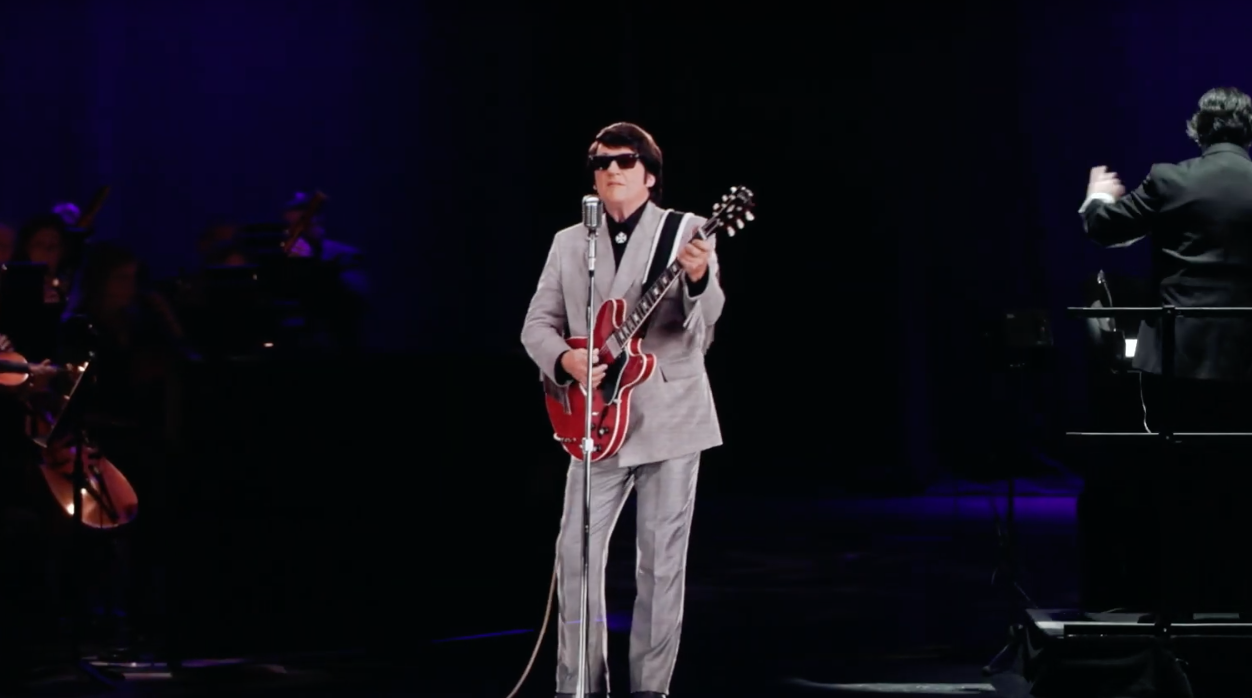The horrible moral and legal implications of hologram tours

In 1965, Elvis Presley made a decision that only a man at the height of his powers could conceivably dream he’d get away with: he sent his Gold Cadillac out on tour, in place of him.
Yup. Elvis was so hot, and so in demand, that crowds of otherwise sane humans flocked to see his car. Just, you know, sitting there. Sure, it was gold, and sure, it belonged to Elvis, but it was hardly the most inspired decision. Still, on the first day of the tour, 50,000 people rocked up to a theatre in Atlanta to check out the King’s wheels and crowds stayed steady as the vehicle hit each stop. If only to prove the pointlessness of this whole enterprise, the car was shipped to each location – it wasn’t even driven there. In 1968, he repeated his feat in Australia and New Zealand, this time upping the ante by sending a few of his Gold records on tour with the vehicle. Aussie fans could buy a souvenir photo of the Cadillac with the car’s specs printed on the back. What delirious teenage girl wouldn’t want such a prize?
In Britain, fed up with screaming crowds drowning out their music, which had recently shifted from ‘pop music’ to ‘art, maaan’, The Beatles became disenchanted with touring and heard about Elvis’ cheeky workaround. While they didn’t quite plummet those same cynical depths, they quit touring altogether, retreated from the road, and began to view their next studio album as a calling card, something to send out on tour in place of them. Without the restraints of needing to recreate the record live, they could freely experiment in the studio. Sitars and that. The result was Sgt. Pepper’s Lonely Hearts Club Band, a record which is seen as their magnum opus, and has been ‘on the road’ for 52 years now, with no signs of running out of gas.
The next wave of cash-in tours, however, makes a live Cadillac appearance seem like a dream. Due to the relentless march of commerce and technology, holograms are reviving the dead and putting them back on the tour bus. This week, Whitney Houston’s sister-in-law, Pat Houston, the sole executor of her estate, announced a hologram of the late singer will be hitting the road this year. Adding to the eerie feeling of this is the fact her old backing band will be joining her on the road, playing the actual music as laser-projected Whitney warbles over the top. It’s unsettling. As is Pat Houston’s quote to the New York Times regarding her decision to unearth Whitney: “Everything is about timing for me,” she explains. “It’s been quite emotional for the past seven years. But now it’s about being strategic.”
The first time we saw this technology used publicly in any major way was during the 2012 Coachella, where Snoop Dogg and Dr Dre performed alongside a hologram 2Pac. The technology was in its nascent stages back then, and so the apparition was closer to seeing Paula Abdul rap with a cartoon cat (Skat Kat, for those playing at home) or Michael Jordan balling alongside Looney Tunes characters. In other words, it was novel, fun, but thoroughly unconvincing.
Times are a-changing. Last October, a hologram Roy Orbison embarked on a 28-date American tour, the largest of its type. Earlier this year, the hologram took up residency at Missouri’s Andy Williams Moon River Theatre — “the first ever hologram residency,” Rolling Stone wrote of the feat, as Roy spun furiously in his grave, shades flying off.
There are clear problems with this technology, from a moral standpoint. Much like any artist who is still profitable after their death, moves will be made to capitalise on their legacy in many murky ways. Traditionally, this has taken the form of vault-digging, where demos, unreleased material, unfinished recordings, or ‘reimagined’ releases are put out in an official capacity, sitting alongside the artist’s own sanctioned work in a way that is largely indistinguishable to those not well-versed in history – a situation that’s even more muddied in this era of indiscriminate streaming. Jeff Buckley released only one album (ten songs, including three covers) and a live four-song EP during his life; one only needs to jump on Spotify to see how prolific he has become after his death. Likewise with the posthumous catalogues of Tupac, Michael Jackson, and Jimi Hendrix, to name but three. Merchandising is less insidious but still undoubtedly tacky. A Bob Marley weed grinder may be fitting, but Kurt Cobain hoodies in K-Mart seems like a step too far. Queen Monopoly anybody?
Label deals have shifted from straight recording and distribution contracts, to 360 deals that see the record company get a piece of merchandising, tour profits, streaming, and anything they write into the contract. It’s not a stretch to see posthumous hologram rights written into future contracts, if indeed this isn’t already happening. In 1968, Frank Zappa released a bitingly satirical record called We’re Only In It For The Money, now his hologram is on tour. Ronnie James Dio recorded a Black Sabbath album in 1992 named Dehumanizer which features a song about a computerised God that his hologram now non-ironically sings to audiences.
On that point, the deals artists sign may not even be for posthumous hologram rights, but ones that exist concurrently. What happens when artists don’t want to tour an album, for whatever reason? Will pissed off label staff use the threat of a hologram doppelgänger going out in their place to force artists to tour? Or what about when an artist moves labels? When Silverchair left Sony after fulfilling their deal, the label released a best of collection, which the band weren’t at all happy about, considering they had only recorded three albums, had just turned 21, and were hardly at a stage of career reflection. “We thought about putting out ads in the street press to make people aware that we weren’t endorsing it,” Daniel Johns told Richard Kingsmill at the time. “But that would have blown the whole thing out of proportion … If people want to buy it, they can buy it – but I wouldn’t buy it if I was a Silverchair fan.”
Had they signed away their hologram rights as teenagers, things could have been much worse for them. Sony could have legally sent hologram Silverchair out on tour to play all the greatest hits, competing with Daniel and co.’s lavish Diorama production. Much like how two “official” versions of Boney M went out on tour during the early ‘00s, differing versions of the hologram experience could start competing with the real thing.
Of course, you say, there’s no way a hologram version can compete with the real thing. Don’t be so sure. How do you account for the enduring success of Madame Tussauds? People aren’t going for the craftsmanship or the uncanny likenesses: The Prince William one looks like one of Napoleon Dynamite’s sketches, and rumour has it that it was so bad it awoke the vengeful ghost of Princess Diana. People still take selfies with it, every few minutes. Or covers bands: versions of Queen, ABBA, Fleetwood Mac and — featuring in my favourite street press ads from the ‘90s — Gold Chisel: The Cold Chisel Experience — make livings approximating the glory days of acts on hiatus. People go to concerts for many reasons, and a big part of the hologram experience will be nostalgia. Who cares if it’s not actually Led Zeppelin – it sounds like them, it looks like them, it feels like them, it makes me sweat and groove like it’s them.
Which throws up an interesting point. How do they decide on which ‘era’ of the star to represent?
I contacted Brian Becker, who is the Chairman and CEO of BASE Hologram, the company behind the Roy Orbison and Whitney Houston tours, and asked him just this.
“It’s really a mix of factors that make up that decision,” he begins, “but ultimately we leave it up to our creative directors and the families/estates.
“Our productions are meant to be a tribute to these musical legends and these projects are deeply personal to them. That close relationship is invaluable so we really want to leave those elements up to them because the whole point here is to preserve the legacies of these one-of-a-kind musicians in the most authentic way possible.”
And what’s stopping the hologram from shapeshifting throughout a lifetime’s worth of hits? Imagine a young John Lennon sliding up to the mic, all suit and bowl haircut, singing malapropisms before 29-year-old John steps in and gives peace a chance. It’s easy if you try.
Becker admits “it is entirely possible we would do a production where the star’s image shifts” but that decision lies with the family.
That’s the playing field at the moment. As the technology gets better, and record labels continue to widen their potential money-making streams, the problem of control and curation over such shows will only become more complex, and legally murky.
Maybe it’s not a problem at all, though, and this will simply be an alternative new form of entertainment, like concert films and Pink Floyd laser shows were in the ‘70s. Whatever the future holds, however, artists need to be more aware than ever of what rights they are signing away, and who controls their image. In the next few years, a band’s main competition for concert dollars might be themselves.
It’s certainly something to think about. Now, I’m off to see Justin Bieber’s Ferrari: live in concert.


































